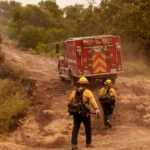MILWAUKEE (AP) — On the floor of the Republican National Convention Tuesday evening, vice presidential candidate JD Vance greeted and shook hands with excited delegates as he walked toward his seat.
It was a marked contrast from former President Donald Trump, who entered the hall a few minutes later and was separated from supporters by a column of Secret Service agents. His ear still bandaged after an attempted assassination, Trump closely hugged the wall. Instead of handshakes or hellos for those gathered, he offered fist pumps to the cameras.
The contrast underscores the new reality facing Trump after a gunman opened fire at his rally in Pennsylvania Saturday, raising serious questions about the agency that is tasked with protecting the president, former presidents and major-party candidates. Trump’s campaign must also adjust to a new reality after he came millimeters from death or serious injury — and as law enforcement warns of the potential for more political violence.
Trump campaign officials declined to comment on the stepped-up security and how it might impact his interactions going forward.
“We do not comment on President Trump’s security detail. All questions should be directed to the United States Secret Service,” said Trump campaign spokesperson Steven Cheung.
Homeland Security Secretary Alejandro Mayorkas, whose agency oversees the Secret Service, said Monday that he could not discuss “specifics of the protection or the enhancements made, as they involve sensitive tactics and procedures. I can say, however, that personnel and other protective resources, technology, and capabilities have been added.”
The Secret Service had already stepped up Trump’s protection in the days before the attack following an unrelated threat from Iran, two U.S. officials said Tuesday. But that extra security didn’t stop the gunman, who fired from an adjacent roof, from killing one audience member and injuring two others along with Trump.
The FBI and Homeland Security officials remain “concerned about the potential for follow-on or retaliatory acts of violence following this attack,” according to a joint intelligence bulletin by Homeland Security and the FBI and obtained by The Associated Press. The bulletin warned that lone actors and small groups will “continue to see rallies and campaign events as attractive targets.”
Underscoring the security risks, a man armed with an AK-47 pistol, wearing a ski mask and carrying a tactical backpack was taken into custody Monday near the Fiserv Forum, where the convention is being held.
The attack has led to stepped-up security not only for Trump. President Joe Biden’s security has also been bolstered, with more agents surrounding him as he boarded Air Force One to Las Vegas on Monday night. Independent candidate Robert F. Kennedy Jr. also received Secret Service protection in the shooting’s wake.
Trump’s campaign has also responded in other ways, including placing armed security at all hours outside their offices in Florida and Washington, D.C.
Trump has already scheduled his next rally in Grand Rapids, Michigan, on Saturday. That’s where he will appear with Vance for their first event as a presidential ticket.
But the new posture complicates, at least for now, the interactions Trump regularly has with supporters as he signs autographs, shakes hands and poses for selfies at events and on airplane tarmacs.
In many cities he visits, the campaign assembles enthusiastic supporters in public spaces like restaurants and fast food joints. Sometimes Trump stops by unannounced. The images and video of his reception and interactions — circulated online by his campaign staffers and conservative media — have been fundamental to his 2024 campaign.
During the GOP primaries, in particular, his easy interactions served as a contrast to his more awkward top rival, Florida Gov. Ron DeSantis.
But those events can get rowdy and chaotic. While he was in New York during his criminal hush money trial, Trump aides arranged a series of visits to a local bodega, a local firehouse and a construction site.
Before his arrival at the bodega in Harlem, thousands of supporters and onlookers gathered behind metal barricades for blocks to watch his motorcade arrive and cheer. But others in the neighborhood were frustrated by the visit, including people being dropped off at a bus stop just in front of the store, and others trying to enter their apartments after work.
At one point, an individual who lived in the building started shouting from a window that was just above the entrance where Trump would eventually stand and give remarks to the cameras and answer reporters’ questions.
Long before the shooting, convention organizers had clashed with the Secret Service over the location of protest zones at the convention. RNC leaders repeatedly asked officials to keep protesters farther back than had been originally planned, arguing that an existing plan “creates an elevated and untenable safety risk to the attending public.”
One person familiar with the dispute said that the original plan would have put protesters “a softball throw away” from delegates and close enough to throw projectiles over the fence.
The protest area was eventually moved, but the episode still raises frustrations and suspicions among some Trump allies.
Associated Press writer Colleen Long in Washington contributed to this report.





